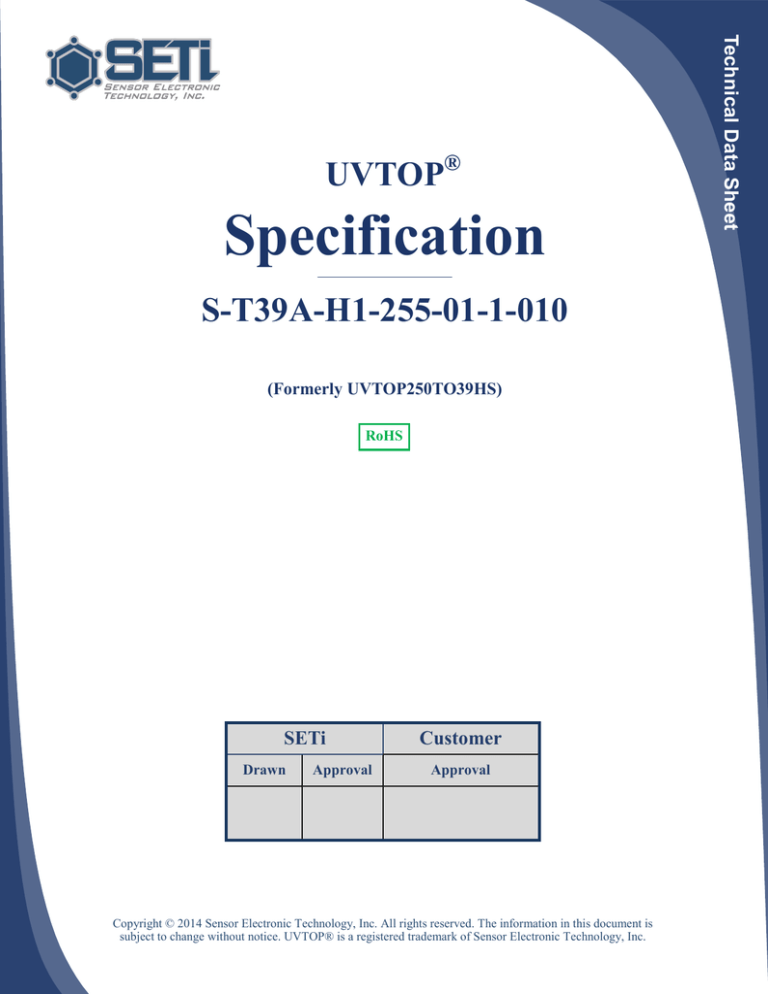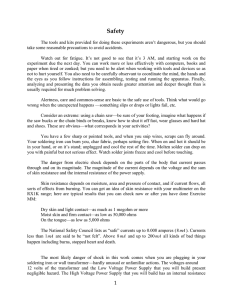
Specification
_______________________________________________________
S-T39A-H1-255-01-1-010
(Formerly UVTOP250TO39HS)
RoHS
SETi
Drawn
Approval
Customer
Approval
Copyright © 2014 Sensor Electronic Technology, Inc. All rights reserved. The information in this document is
subject to change without notice. UVTOP® is a registered trademark of Sensor Electronic Technology, Inc.
Technical Data Sheet
Technical Data Sheet
UVTOP®
Technical Data Sheet
Table of Contents:
1. Description
2. Mechanical Dimensions
3. Characteristics of S-T39A-H1-255-01-1-010
4. Characteristic Diagrams
5. Labeling
6. Soldering Conditions
7. Precaution for Use
8. Revision History
1
Copyright © 2014 Sensor Electronic Technology, Inc. All rights reserved. The information in this document is
subject to change without notice. UVTOP® is a registered trademark of Sensor Electronic Technology, Inc.
2
Technical Data Sheet
Mechanical Dimensions
Material Information
PKG Body
TO39
Lens
Hemispherical
Notes:
[1] All dimensions in millimeters
[2] Scale: none
[3] Undefined tolerance: .XXX = +/- .1
2
Copyright © 2014 Sensor Electronic Technology, Inc. All rights reserved. The information in this document is
subject to change without notice. UVTOP® is a registered trademark of Sensor Electronic Technology, Inc.
3
1.1 Electro-Optical Characteristics at 20mA
Tₐ = 25oC, with external heat sink Rth (sp-a)[5] ≤ 20 °C/W, Forward Current=20mA, RH = 30%
Parameter
Symbol
Minimum
Peak Wavelength[1]
λp
250
Optical Output Power[2]
Popt[3]
0.10
Forward Voltage[4]
VF
6.0
7.0
V
FWHM
Δλ
11
14
nm
Viewing Angle
2θ1/2
7
⁰
Thermal Resistance (Tj-Tsp)
Rth
50
⁰C/W
Typical
Maximum
Unit
260
nm
0.3
1.2 Absolute Maximum Ratings
Technical Data Sheet
Characteristics of S-T39A-H1-255-01-1-010
mW
Tₐ= 25
Parameter
Symbol
Value
Unit
Forward Current
IF
20
mA
Power Dissipation
Pd
180
mW
Reverse Voltage
Vr
-6
V
Junction Temperature
Tj
60
⁰C
Storage Temperature
Tstg
100
⁰C
Notes:
[1] Peak wavelength measurement accuracy is ± 2 nm
[2] Optical Output Power measurement accuracy is ± 10%
[3] Popt is the Optical Output Power as measured with an integrated sphere
[4] Forward voltage measurement accuracy is ± 2%
[5] Rth(sp-a) defined as thermal resistance from solder point to ambient
[6] The exposure to the absolute maximum rated conditions may affect device reliability
[7] The stresses beyond those listed under absolute maximum rating may cause permanent damage to the device
Copyright © 2014 Sensor Electronic Technology, Inc. All rights reserved. The information in this document is
subject to change without notice. UVTOP® is a registered trademark of Sensor Electronic Technology, Inc.
3
4
www.s-et.com ● +1 (803) 647-9757 ● sales@s-et.com
1. Relative Spectral Power Distribution
Tₐ =25 °C, RH=30%
Normalized output power
1.0
Technical Data Sheet
Characteristic Diagrams
0.8
0.6
0.4
0.2
0.0
225 230 235 240 245 250 255 260 265 270 275 280 285 290
Wavelength, nm
2. Forward Current vs. Forward Voltage
Tₐ =25 °
7.5
7.0
Forward voltage, V
6.5
6.0
5.5
5.0
4.5
4.0
3.5
3.0
0
5
10
15
20
25
30
35
40
45
Forward current, mA
5
Copyright © 2014 Sensor Electronic Technology, Inc. All rights reserved. The information in this document is
subject to change without notice. UVTOP® is a registered trademark of Sensor Electronic Technology, Inc.
4
25
5
www.s-et.com ● +1 (803) 647-9757 ● sales@s-et.com
Technical Data Sheet
3. Relative Optical Output Power vs. Forward Current
Tₐ =25 °C
0.60
Power (mW)
0.45
0.30
0.15
0.00
0
5
10
15
20
25
30
Current (mA)
4. Peak Wavelength vs. Forward Current
Tₐ =25 °C
280
Wavelength,nm
270
260
250
240
230
0
5
10
15
20
25
30
Current, mA
Copyright © 2014 Sensor Electronic Technology, Inc. All rights reserved. The information in this document is
subject to change without notice. UVTOP® is a registered trademark of Sensor Electronic Technology, Inc.
5
4
6
Technical Data Sheet
5. Forward Voltage vs. Ambient Temperature
Normalized forward voltage
at 20 mA forward current
1.1
1.0
0.9
0.8
0
5
10 15 20 25 30 35 40 45 50 55 60
o
Temperature, C
6. Typical Angular Diagram
If =20mA
Copyright © 2014 Sensor Electronic Technology, Inc. All rights reserved. The information in this document is
subject to change without notice. UVTOP® is a registered trademark of Sensor Electronic Technology, Inc.
6
6
7
Technical Data Sheet
Soldering Conditions
Solder no closer than 3mm from the base of the header.
Following conditions must be avoided during soldering: overheating, ESD, mechanical shock,
vibration, ultrasonic shock, mechanical damage and contamination.
• Only solder to the package leads. Soldering to the LED header or the cap will result in
damage to the device.
• If clamping the LED is required, mechanical stress on the LED should be minimized.
• Mechanical stress, shock and vibration must be avoided during soldering.
• Do not mount the LED directly on the PCB or heat sink by soldering directly to the LED
header or cap.
• Only use non-corrosive flux.
• Only cut device leads at room temperature using an ESD protected tool. Do not apply
stress to the leads while hot.
• Do not apply current to the device until it has cooled down to room temperature after
soldering.
• When forming leads, the leads should be bent at a point at least 3mm from the base of
the header.
• Form leads prior to soldering.
• Do not use header or can of LED to form leads.
Recommended Soldering Conditions
Dip Soldering
Hand Soldering
Pre-Heat Time
30 seconds, max.
Temperature at
Solder Point
190° C
Solder Bath Temperature
190° C
Soldering Time
5 seconds, max.
Dipping Time
5 seconds, max.
The above table contains the maximum specifications for the soldering conditions. However, it is
recommended that soldering always be performed at the lowest possible temperature.
Cleaning
Cleaning with isopropyl alcohol is recommended.
28 Propanol and ethyl alcohol may also be used.
28
DO NOT USE acetone, chloroseen, trichloroethylene,
or MKS to clean the LEDs.
Do not use ultrasonic cleaners with the LEDs.
8
Copyright © 2014 Sensor Electronic Technology, Inc. All rights reserved. The information in this document is
subject to change without notice. UVTOP® is a registered trademark of Sensor Electronic Technology, Inc.
8
Technical Data Sheet
Precaution for Use
UV Light
These devices are ultraviolet LEDs. During operation, the LED emits high intensity ultraviolet (UV) light, which is
harmful to skin and eyes.
UV light is hazardous to skin and may cause cancer. Avoid exposure to UV light when LED is operational.
Precautions must be taken to avoid looking directly at the UV light without the use of UV light protective glasses. Do
not look directly at the front of the LED or at the LED’s lens when LED is operational.
Attach the following warning labels on products/systems that use UV LEDs.
Static Electricity
These products are ESD (electrostatic discharge) sensitive; static electricity and surge voltages seriously damage UV LEDs and can
result in complete failure of the device. Precautions must be taken against ESD when handling or operating these devices.
Operating Conditions
In order to ensure the correct functioning of these LEDs, compliance to the maximum electrical specifications is paramount.
These LEDs are particularly sensitive to any current value that exceeds the absolute maximum rating of the product. Any applied
current in excess of the maximum specification will cause damage and possible complete failure of the product.
The current flowing in a LED is an exponential function of the voltage across it. A small change in voltage can produce a very
large change in current and lead to complete failure of the LED. The use of current regulated drive circuits are recommended for
these products.
Any attempt to drive these UV LEDs with a voltage source instead of a current source will cause damage and possible complete failure of the product.
These LEDs are susceptible to heat generation. Use care to design end product with adequate thermal management
to ensure that LEDs do not exceed maximum recommended temperatures. Operating LEDs at temperatures in excess of specification will result in damage and possible complete failure of the product.
9
Copyright © 2014 Sensor Electronic Technology, Inc. All rights reserved. The information in this document is
subject to change without notice. UVTOP® is a registered trademark of Sensor Electronic Technology, Inc.
9
Technical Data Sheet
Revision History
Revision
Change Date
01
October 16, 2015
Authorized Signature
10
Copyright © 2014 Sensor Electronic Technology, Inc. All rights reserved. The information in this document is
subject to change without notice. UVTOP® is a registered trademark of Sensor Electronic Technology, Inc.
10



